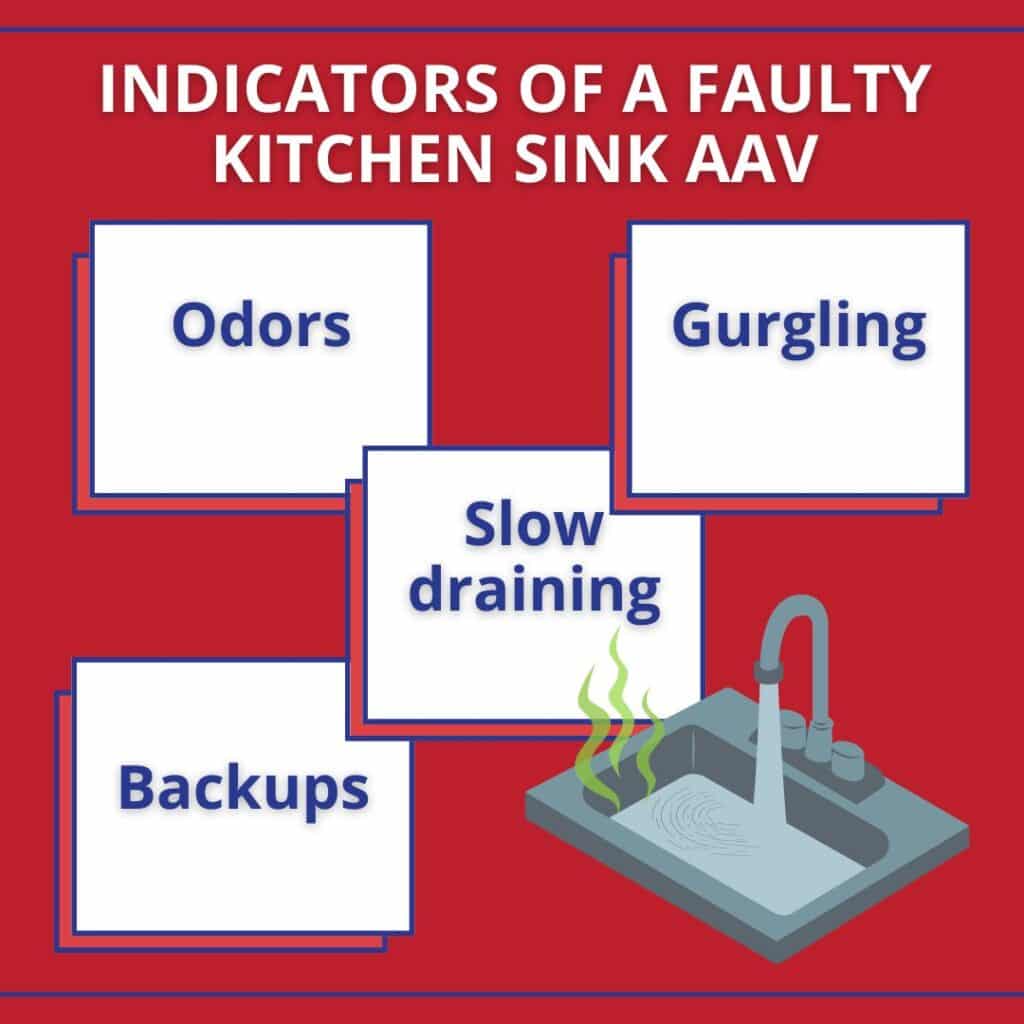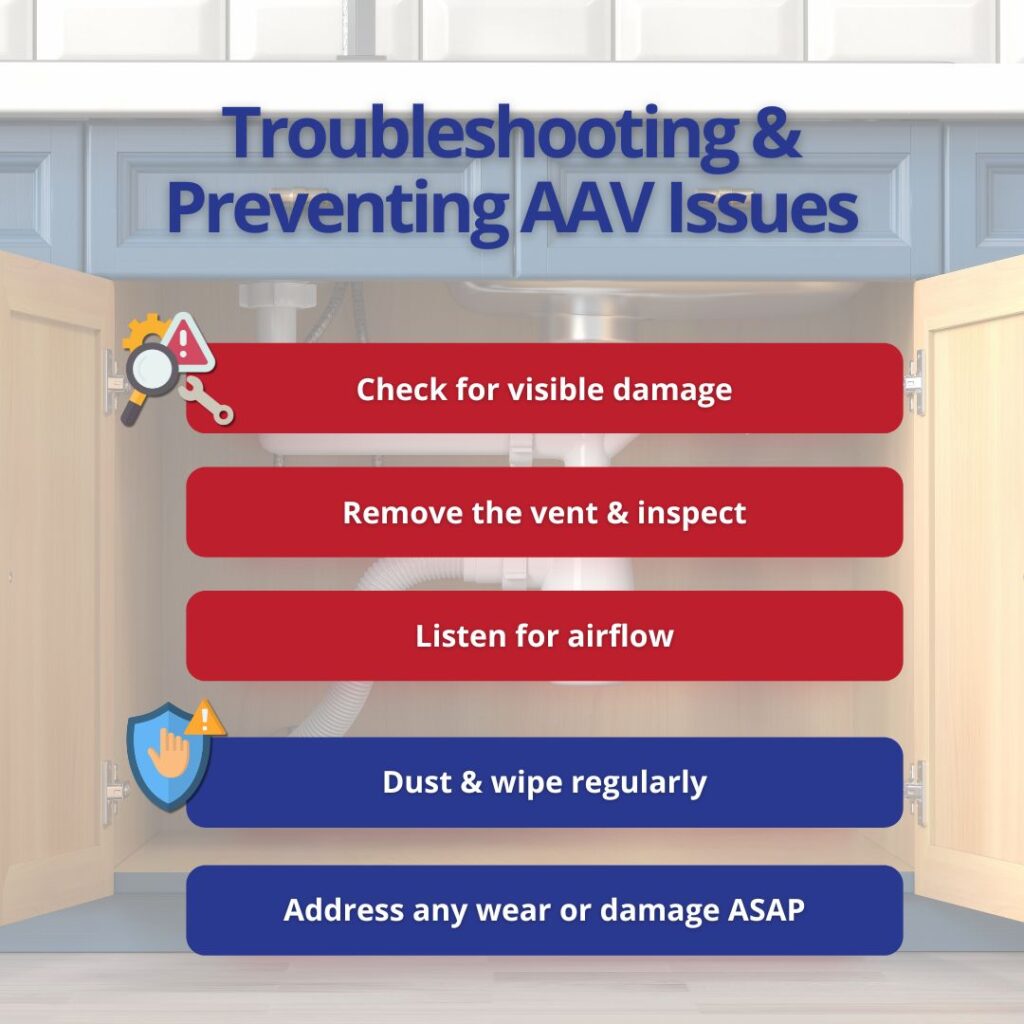A faulty kitchen sink mechanical vent can cause slow drainage, gurgling sounds, and even foul odors without proper troubleshooting or repair. Since these vents help regulate airflow in plumbing, a problem can make it seem like your sink is clogged when the real issue is ventilation.
Luckily, troubleshooting a mechanical vent for your kitchen sink is often simple. This guide covers what a kitchen sink mechanical vent does, signs it’s failing, and how to troubleshoot it—safely and quickly.
What a Mechanical Vent Does and Why It Matters
These vents, often an Air Admittance Valve (AAV) are used when a sink isn’t connected to a traditional vent pipe that runs through the roof. Without enough airflow, water can’t move through the pipes efficiently, leading to slow drainage, gurgling, and even sewer odors.
Traditional plumbing vents connect to pipes that run through the roof to release air. But in some homes, especially those with island sinks or older plumbing setups, adding a full vent system isn’t practical.
Instead, the mechanical vent opens when water flows, allowing air in to prevent suction from slowing the drain. Once the water stops, the vent closes to keep sewer gases from escaping into your home.
If it fails, your sink may start acting clogged even when there’s no blockage in the drain.

Signs Your Mechanical Vent Isn’t Working
A faulty kitchen sink mechanical vent can mimic common plumbing problems, making it easy to overlook.
If your sink is draining slowly or making strange noises, the vent could be the culprit. Watch for these warning signs:
- Water drains slowly or backs up even after clearing the pipes
- Gurgling sounds when water drains, signaling trapped air struggling to escape
- Unpleasant odors near the sink, possibly from sewer gases leaking inside
- No change after plunging or snaking the drain, suggesting the issue isn’t a clog
Since a mechanical vent is designed to regulate airflow, any disruption can create suction problems in the pipes. If your sink shows these signs, checking the vent should be your next step.
Troubleshooting a Kitchen Sink Mechanical Vent
If your kitchen sink isn’t draining properly and you suspect the mechanical vent is to blame, a few simple checks can help pinpoint the problem.
- Look for visible damage – Cracks, loose fittings, or warping can prevent the vent from sealing properly. If the vent looks worn out, replacing it may solve the issue.
- Remove and inspect the vent – Unscrew the vent and check inside for dust, grease, or debris. A clogged vent can restrict airflow, mimicking a drain blockage. Clean it out and reinstall to see if performance improves.
- Listen for airflow – When working correctly, the vent should let air in quietly as water drains. If you hear a wheezing or struggling sound, the valve may be stuck or faulty.
- Test the drain without the vent – Temporarily remove the vent and run water. If the sink drains faster, the vent is likely the problem. Replacing it with a new air admittance valve may be the best fix.
- Check for improper installation – Vents should be installed upright, at the right height, and in an area with enough airflow. If it’s too low or tucked into a tight space, it may not function properly.
If troubleshooting doesn’t resolve the issue, the problem could be deeper in the plumbing system.

Preventative Maintenance to Avoid Future Issues
Mechanical vents are simple devices, but regular maintenance can help you avoid problems like slow drainage or sewer odors.
Prevent common vent failures by keeping your plumbing system clean and checking the vent periodically.
- Clean the vent regularly – Dust, debris, and grease can accumulate inside and block airflow. Unscrew the vent, wipe it clean, and check for buildup.
- Avoid pouring grease or food debris down the sink – Grease and food particles can travel through the pipes and build up around the vent, restricting airflow.
- Inspect for wear and damage – Mechanical vents can wear out over time. Check for cracks, rust, or warping, and replace the vent if it shows signs of damage.
- Make sure the vent sits properly – It should be upright and in a location with adequate airflow for it to function effectively.
With regular upkeep, you can prevent many mechanical vent failures and avoid costly drainage problems.
When to Call a Professional
If your sink is still having problems after troubleshooting, it may be time to bring in a professional. Some drainage issues can be signs of bigger problems, like venting system failures or blockages in your home’s main plumbing line.
Call a professional if you notice:
- Persistent slow drainage even after vent cleaning or replacement
- Sewer odors that don’t go away after troubleshooting
- Gurgling sounds that continue, even after clearing the vent
- Issues with other plumbing fixtures in the home, indicating a larger venting or plumbing problem
A professional property inspector can help identify and confirm whether the mechanical vent is the problem or if the issue lies elsewhere in your plumbing system.
Conclusion
A faulty kitchen sink mechanical vent can cause frustrating problems like slow drainage and foul odors, but simple troubleshooting can often reveal the issue. Regular maintenance can prevent clogs and damage, but if problems persist, calling a professional is the safest way to protect your home’s plumbing system.
For homeowners who want peace of mind, America’s Choice Inspections can help identify venting issues and catch hidden plumbing concerns before they become costly repairs. Reach out to schedule a thorough property inspection today.


